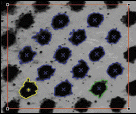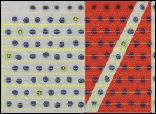Daniel C. McCarthy, Senior Editor/Special Projects
Not too long ago, computer enthusiasts were predicting that all business communication would occur electronically and that printed documents would become obsolete. This vision didn't seem to negatively influence desktop printer sales or the demand for better, faster, cheaper printers -- not if the prosperity of companies such as ImageXpert Inc. is any indication.
The company is a leading manufacturer of automated image-quality inspection systems for electronic printing equipment such as desktop printers and scanners. Its systems inspect printed test targets for line and dot quality, dot placement, color registration and other attributes. ImageXpert provides a variety of modular instruments, all of which image with CCD video cameras through fluorescent ringlights manufactured by StockerYale.
"Ninety-five percent of machine vision fails because of the lighting -- not the CCD, not the lens, but rather the lighting," said Yair Kipman, president of ImageXpert. "Lighting is component No. 1 in machine vision, and for us it's like life or death."

 Quality control of new desktop printers requires inspection of printed test targets. As in most printed images, the figures on these test targets comprise thousands of tiny dots that, when inspected for quality, placement and other attributes, indicate whether a printer source is operating properly. Cameras used for these inspections require stable, uniform light sources to ensure that any aberrations detected are the result of poor printer performance and not the illumination. One instrument maker found that
fluorescent ringlights provide the solution. Courtesy of ImageXpert Inc.
Quality control of new desktop printers requires inspection of printed test targets. As in most printed images, the figures on these test targets comprise thousands of tiny dots that, when inspected for quality, placement and other attributes, indicate whether a printer source is operating properly. Cameras used for these inspections require stable, uniform light sources to ensure that any aberrations detected are the result of poor printer performance and not the illumination. One instrument maker found that
fluorescent ringlights provide the solution. Courtesy of ImageXpert Inc.
Measurement of printed test targets requires uniform distribution of light from a stable source to ensure that any aberrations detected by the camera are the result of poor printer quality and not the illumination. Previously, the company relied on high-intensity halogen sources, which are more stable than fluorescent illumination but which fade more quickly and can have a radially nonuniform distribution of light.
Although fluorescent sources do provide uniform illumination, they can flicker. This subverts the gray values detected by the CCD camera and causes problems when measuring the very small dots in today's high-resolution printers, or images produced with low-contrast colorants. Despite this, ImageXpert sampled fluorescent ringlights from several suppliers and found that StockerYale's high-frequency sources were twice as stable as other fluorescent sources.
Besides providing adequate stability, the ringlights delivered 2 to 3 percent variation in illumination compared with 12 to 16 percent of earlier halogen sources. Also, Kipman said they last about a year before users need to change the lamp. ImageXpert provides automated verification that ensures that the camera is calibrated to the actual lamp's output.